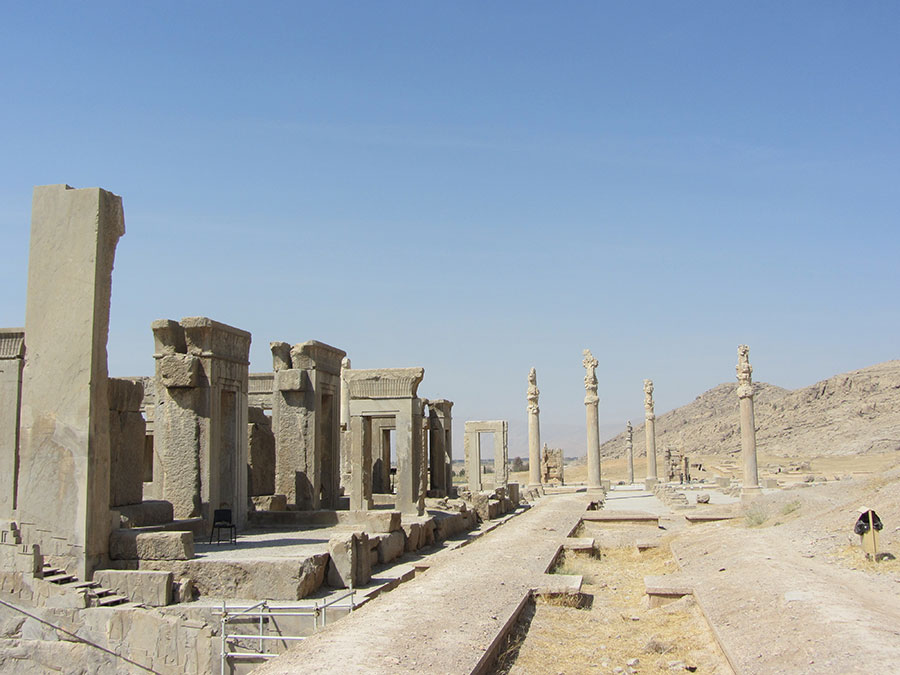The Meaning of Trump’s Threat to Hit Iranian Cultural Sites
It’s a refusal to learn anything about a culture that could be obliterated
It’s a refusal to learn anything about a culture that could be obliterated

What a pity to see a mind as great as Napoleon’s devoted to trivial things such as empires, historic events, the thundering of cannons and of men; he believed in glory, in posterity, in Caesar; nations in turmoil and other trifles absorbed all his attention... How could he fail to see that what really mattered was something else entirely?
Paul Valéry
Mauvaises pensées et autres (1942)
Two hundred years ago, Napoleon Bonaparte ordered the destruction of the most significant Islamic monument in Europe. In 1812, his forces looted and vandalized the Alhambra complex in Granada, before attempting to blow it up entirely as they retreated from the city. Only the quick thinking of a crippled soldier, who had been discarded as a burden by Napoleon, saved the palace from becoming rubble.

US President Donald Trump’s threat to bomb cultural sites in Iran, which he reiterated in person after Pentagon officials downplayed his tweets from 4 January, was intended not only to goad Iranians. The destruction of a nation’s cultural heritage is a means of erasing its identity, and of narrowing the perception of its humanity, ensuring that depictions of Iran are reduced solely to images of fanatical clerics and baying mobs.
Trump’s rhetoric offers his supporters a state-sponsored endorsement of wilful ignorance; of not deigning to learn anything about the culture that will be obliterated, lest they be confronted by its creativity. Iran (eye-ran) must be located in a vague geography of hostility – a mere consonant away from invasion. Iranians’ perpetual desire to distinguish themselves from their Arab neighbours expresses both a demand for recognition and a frustration with the careless conflation that characterizes American attitudes to the region.
Europe, by contrast, has a particular orientalist perception of Iranian civilization. Indeed, the country was long known by the exonym of Persia, a word derived from Greek and disseminated through Herodotus’ Histories (440 BCE). The name is redolent with classical associations – of noble Cyrus and Darius and of Xerxes’ heroic failure – and is now favoured by many in the diaspora, including some of my family, against the image of Iran as a site of philistine fundamentalism. (In fact, it was Reza Shah Pahlavi who instituted the name change, more than four decades before the birth of the Islamic Republic in 1979.)

Europe’s literary imagination was furnished with portraits of Persian grandeur – of tipsy Sufi poets in the rose-scented gardens of Shiraz. The works of Hafiz, Rumi, Ferdowsi and Saadi were mythologized and transmuted, although none as potently as Edward FitzGerald’s 1859 translation of Omar Khayyam’s Rubáiyát. FitzGerald’s lyrical rendering is a loose translation at best, but one that reflects the enthusiasm of the era: he studied Farsi with the poet laureate, Alfred Lord Tennyson, who as an undergraduate had penned a clumsy paean:
In the flowery land of Persia
Long ago, as poets tell,
Where three rivers met together
Did a happy people dwell.
Never did these happy people
Suffer sickness, plague, or dearth,
Living in a golden climate
In the fairest place on earth.
The elegant ruin that came to symbolize Persia’s fall from grace is the ancient city of Persepolis, with its exquisite Zoroastrian ornamentation. Persepolis occupies a profile akin to that of Palmyra in Syria, which helps clarify how cultural heritage has been weaponised in recent years. UK Prime Minister Boris Johnson, who said in 2008 that he ‘could happily spend a week picking through Persepolis’, wrote an infamous article praising the Syrian regime after its ‘defence’ of Palmyra, claiming: ‘The victory of Assad is a victory for archaeology.’ Unable to justify military intervention in terms of safeguarding the future – the democratic panacea once offered by neoconservatism – we now intervene on behalf of the dead (preferably ancient and pre-Islamic).

Meanwhile, living citizens in the Middle East observe a subtle sleight of hand in discussions of their sovereignty. Their ongoing experience of tyranny is taken as a reflection of their inflexible mentality (never mind that it is a direct consequence of botched British imperialism), but their cultural gems are jointly ours. All that is virtuous is universalized; all that is villainous is localized. The Persians are ‘wily’ but the English never cease to play fair – just admire our disinterested curation of other people’s treasures at the British Museum! The dingy Duveen Gallery renders inert the Parthenon Marbles, but perhaps that’s the point: to encase this heritage in aspic, thereby negating any claims of continuity.
Europe likes to regard itself as a protector of global patrimony, but the continent is not immune to fits of cultural destruction. One doesn’t need to be a conservative architecture professor lamenting the tearing down of Victorian railway stations to regard with suspicion the modernist wrecking-ball. The Futurist writer Filippo Tommaso Marinetti, who fetishized war as ‘the only cure for the world’, yearned for the desecration of his own civilization:
Come on! set fire to the library shelves! Turn aside the canals to flood the museums!... Oh, the joy of seeing the glorious old canvases bobbing adrift on those waters, discoloured and shredded!... Take up your pickaxes, your axes and hammers and wreck, wreck the venerable cities, pitilessly!

Napoleon’s military education failed to teach him a valuable lesson: that half of being civilized is knowing what not to destroy. In its heyday during the 11th century, the Taifa Kingdom of Granada was administered by a Jewish vizier, Shmu’el HaNagid, who became the most senior general in its all-Muslim army. Like a Jew in Cyrus’ Persia, HaNagid knew a thing or two about mediating cultural difference, and about the fragile web of civilizations, so carefully weaved and so easily undone. First employed as an Arabic scribe, he also wrote Hebrew poetry, including these lines (to a Napoleon, or a Trump) translated by Peter Cole:
It’s heart that discerns
between evil and good
so work to develop your heart.
How many are there
who heartless destroy
and think their destruction a start?
Main image: Sheikh Lotfollah Mosque, Isfahan, Iran, 2008. Courtesy: Wikimedia Commons



















